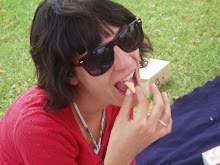I never knew Spanish paella ("puh-eh-ya" in Espanol) and the Aussie barbie had a commonality. Speaking in generalisations here, cooking the barbecue is the man's job in Australia, men compare their barbecues as a way of sizing up each other's manhood, and it seems the same goes for the paella - in Spain it's customary for men to make it.
I let AJ off the hook, though, and continued on my merry way, launching myself into week 50 with a full stomach. Sunday was a day of intense eating. It started with yum cha, followed by a beautiful-tasting feast of mega proportions at Sal's baby shower, and finally the curtain closed with paella about 9.30pm.
Paella is classically cooked over coals in a shallow two-handled pan. Workers would make the paella in the fields from whatever they could find - often snails and rabbit - then all sit around, each with a wooden spoon in hand and eat from the same pan.
Without the hot coals or the paellera or caldero (the pan), I set to work using my trusty deep Scanpan frying pan. Rather than hunks of rabbit and slimy snails, I opted for more palatable ingredients and chose chicken and chorizo as my flavour combo. Even though chorizo is a fantastically smoky Spanish sausage, it's generally not used in Spain for a paella, but I couldn't resist - I love it.
The all-important ingredient in paella is rice. The best recipes don't use too many ingredients because the rice is the hero. Most often it's calasparra rice, and sometimes cebolla rice, a short to medium grain that's ideal for absorbing all the amazing flavours in the paella, such as saffron, paprika, garlic, beans and the sofrito.
I was worried when making my sofrito - the deliciously flavoursome sauce base of tomato, capsicum, onion and garlic cooked slowly (sofrito means "softly fry") in lots of olive oil. AJ (calling out from the other room): "Wow - you must be using a whole lot of spices I've never smelt before." Me: "No babe, I think it's burnt!" It looked a bit black, but didn't taste burnt, so maybe that was how it was supposed to be?
According to the experts, there are a few rules when making paella. Once you add the rice, you must stop stirring. Apparently if you stir, the starch in the rice is released which can make the paella gluey. Then, when you've finished cooking, you need to let the paella rest for about 10 minutes so the rice can relax and the flavours settle.
The paella is a sharing-is-caring dish. The idea is that you bring it to the table in the pan and serve everyone from there. Our "everyone" was just the two of us, and luckily we didn't have to share (although I did share the leftovers). It arrested us at first bite - YUM. The flavour was rich and fabulous, nicely spiced and well seasoned. AJ puts it in Dest. Deg.'s top five.
I served it with a sharp-tasting side of cooked carrots tossed in toasted fennel seeds, lemon juice, mint, oregano and a dressing of red wine vinegar and olive oil that had suitcases (a step up from bags) of flavour. Try it for a different way to serve your vegies. Ideal hot or cold, as a side or a starter. It's Frank Camorra's (of Melbourne restaurant Movida - you may remember him as the one who Marion beat in the challenge on MasterChef) recipe and he says it can be served as an "unassuming appetiser that gets the digestive juices flowing". Buen provecho! x
Subscribe to:
Post Comments (Atom)







I was the lucky one who got to share paella for lunch the next day! Thanks Jacq - it was deeeeelicious. Muy sabroso!
ReplyDelete